Critical Evaluation of Marketing Theories: 4P Marketing Mix, Boston Matrix, Porter's Five Forces
VerifiedAdded on 2023/01/12
|8
|1372
|55
AI Summary
This report critically evaluates three marketing theories: 4P marketing mix, Boston Matrix Boston Consulting Group, and Porter’s five forces theory. It discusses the concepts, advantages, and limitations of each theory.
Contribute Materials
Your contribution can guide someone’s learning journey. Share your
documents today.

Assessment
Secure Best Marks with AI Grader
Need help grading? Try our AI Grader for instant feedback on your assignments.
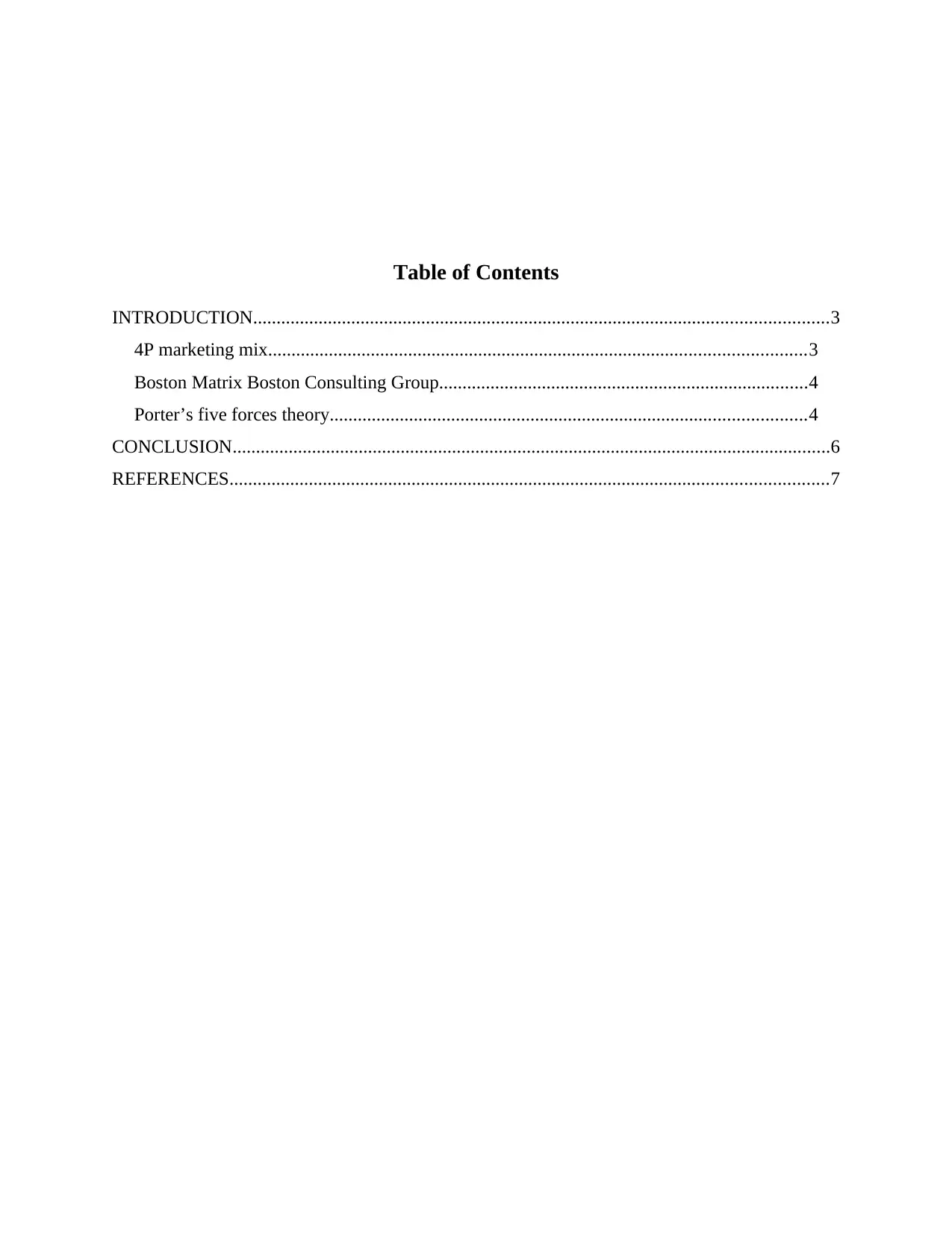
Table of Contents
INTRODUCTION...........................................................................................................................3
4P marketing mix...................................................................................................................3
Boston Matrix Boston Consulting Group...............................................................................4
Porter’s five forces theory......................................................................................................4
CONCLUSION................................................................................................................................6
REFERENCES................................................................................................................................7
INTRODUCTION...........................................................................................................................3
4P marketing mix...................................................................................................................3
Boston Matrix Boston Consulting Group...............................................................................4
Porter’s five forces theory......................................................................................................4
CONCLUSION................................................................................................................................6
REFERENCES................................................................................................................................7
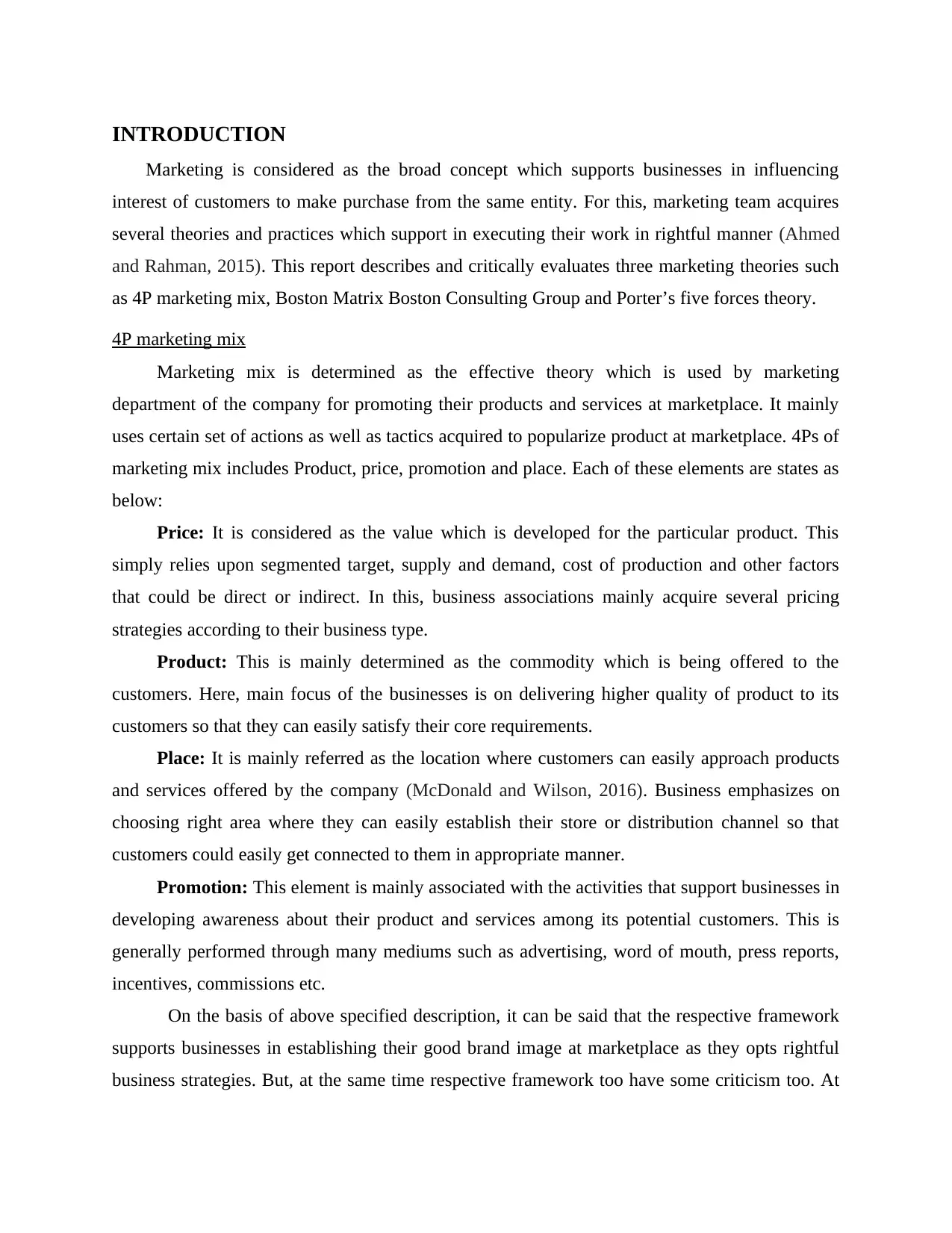
INTRODUCTION
Marketing is considered as the broad concept which supports businesses in influencing
interest of customers to make purchase from the same entity. For this, marketing team acquires
several theories and practices which support in executing their work in rightful manner (Ahmed
and Rahman, 2015). This report describes and critically evaluates three marketing theories such
as 4P marketing mix, Boston Matrix Boston Consulting Group and Porter’s five forces theory.
4P marketing mix
Marketing mix is determined as the effective theory which is used by marketing
department of the company for promoting their products and services at marketplace. It mainly
uses certain set of actions as well as tactics acquired to popularize product at marketplace. 4Ps of
marketing mix includes Product, price, promotion and place. Each of these elements are states as
below:
Price: It is considered as the value which is developed for the particular product. This
simply relies upon segmented target, supply and demand, cost of production and other factors
that could be direct or indirect. In this, business associations mainly acquire several pricing
strategies according to their business type.
Product: This is mainly determined as the commodity which is being offered to the
customers. Here, main focus of the businesses is on delivering higher quality of product to its
customers so that they can easily satisfy their core requirements.
Place: It is mainly referred as the location where customers can easily approach products
and services offered by the company (McDonald and Wilson, 2016). Business emphasizes on
choosing right area where they can easily establish their store or distribution channel so that
customers could easily get connected to them in appropriate manner.
Promotion: This element is mainly associated with the activities that support businesses in
developing awareness about their product and services among its potential customers. This is
generally performed through many mediums such as advertising, word of mouth, press reports,
incentives, commissions etc.
On the basis of above specified description, it can be said that the respective framework
supports businesses in establishing their good brand image at marketplace as they opts rightful
business strategies. But, at the same time respective framework too have some criticism too. At
Marketing is considered as the broad concept which supports businesses in influencing
interest of customers to make purchase from the same entity. For this, marketing team acquires
several theories and practices which support in executing their work in rightful manner (Ahmed
and Rahman, 2015). This report describes and critically evaluates three marketing theories such
as 4P marketing mix, Boston Matrix Boston Consulting Group and Porter’s five forces theory.
4P marketing mix
Marketing mix is determined as the effective theory which is used by marketing
department of the company for promoting their products and services at marketplace. It mainly
uses certain set of actions as well as tactics acquired to popularize product at marketplace. 4Ps of
marketing mix includes Product, price, promotion and place. Each of these elements are states as
below:
Price: It is considered as the value which is developed for the particular product. This
simply relies upon segmented target, supply and demand, cost of production and other factors
that could be direct or indirect. In this, business associations mainly acquire several pricing
strategies according to their business type.
Product: This is mainly determined as the commodity which is being offered to the
customers. Here, main focus of the businesses is on delivering higher quality of product to its
customers so that they can easily satisfy their core requirements.
Place: It is mainly referred as the location where customers can easily approach products
and services offered by the company (McDonald and Wilson, 2016). Business emphasizes on
choosing right area where they can easily establish their store or distribution channel so that
customers could easily get connected to them in appropriate manner.
Promotion: This element is mainly associated with the activities that support businesses in
developing awareness about their product and services among its potential customers. This is
generally performed through many mediums such as advertising, word of mouth, press reports,
incentives, commissions etc.
On the basis of above specified description, it can be said that the respective framework
supports businesses in establishing their good brand image at marketplace as they opts rightful
business strategies. But, at the same time respective framework too have some criticism too. At
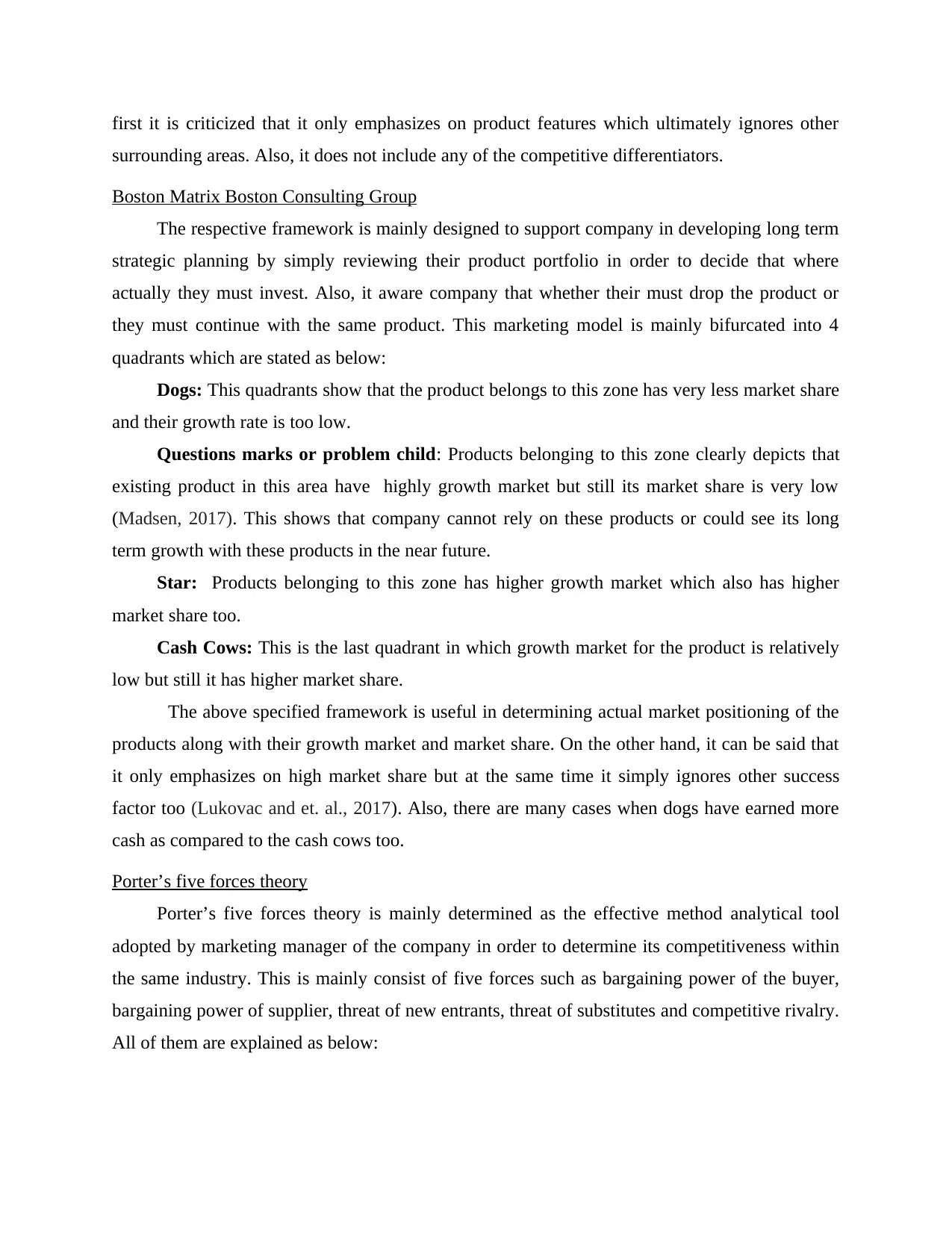
first it is criticized that it only emphasizes on product features which ultimately ignores other
surrounding areas. Also, it does not include any of the competitive differentiators.
Boston Matrix Boston Consulting Group
The respective framework is mainly designed to support company in developing long term
strategic planning by simply reviewing their product portfolio in order to decide that where
actually they must invest. Also, it aware company that whether their must drop the product or
they must continue with the same product. This marketing model is mainly bifurcated into 4
quadrants which are stated as below:
Dogs: This quadrants show that the product belongs to this zone has very less market share
and their growth rate is too low.
Questions marks or problem child: Products belonging to this zone clearly depicts that
existing product in this area have highly growth market but still its market share is very low
(Madsen, 2017). This shows that company cannot rely on these products or could see its long
term growth with these products in the near future.
Star: Products belonging to this zone has higher growth market which also has higher
market share too.
Cash Cows: This is the last quadrant in which growth market for the product is relatively
low but still it has higher market share.
The above specified framework is useful in determining actual market positioning of the
products along with their growth market and market share. On the other hand, it can be said that
it only emphasizes on high market share but at the same time it simply ignores other success
factor too (Lukovac and et. al., 2017). Also, there are many cases when dogs have earned more
cash as compared to the cash cows too.
Porter’s five forces theory
Porter’s five forces theory is mainly determined as the effective method analytical tool
adopted by marketing manager of the company in order to determine its competitiveness within
the same industry. This is mainly consist of five forces such as bargaining power of the buyer,
bargaining power of supplier, threat of new entrants, threat of substitutes and competitive rivalry.
All of them are explained as below:
surrounding areas. Also, it does not include any of the competitive differentiators.
Boston Matrix Boston Consulting Group
The respective framework is mainly designed to support company in developing long term
strategic planning by simply reviewing their product portfolio in order to decide that where
actually they must invest. Also, it aware company that whether their must drop the product or
they must continue with the same product. This marketing model is mainly bifurcated into 4
quadrants which are stated as below:
Dogs: This quadrants show that the product belongs to this zone has very less market share
and their growth rate is too low.
Questions marks or problem child: Products belonging to this zone clearly depicts that
existing product in this area have highly growth market but still its market share is very low
(Madsen, 2017). This shows that company cannot rely on these products or could see its long
term growth with these products in the near future.
Star: Products belonging to this zone has higher growth market which also has higher
market share too.
Cash Cows: This is the last quadrant in which growth market for the product is relatively
low but still it has higher market share.
The above specified framework is useful in determining actual market positioning of the
products along with their growth market and market share. On the other hand, it can be said that
it only emphasizes on high market share but at the same time it simply ignores other success
factor too (Lukovac and et. al., 2017). Also, there are many cases when dogs have earned more
cash as compared to the cash cows too.
Porter’s five forces theory
Porter’s five forces theory is mainly determined as the effective method analytical tool
adopted by marketing manager of the company in order to determine its competitiveness within
the same industry. This is mainly consist of five forces such as bargaining power of the buyer,
bargaining power of supplier, threat of new entrants, threat of substitutes and competitive rivalry.
All of them are explained as below:
Secure Best Marks with AI Grader
Need help grading? Try our AI Grader for instant feedback on your assignments.
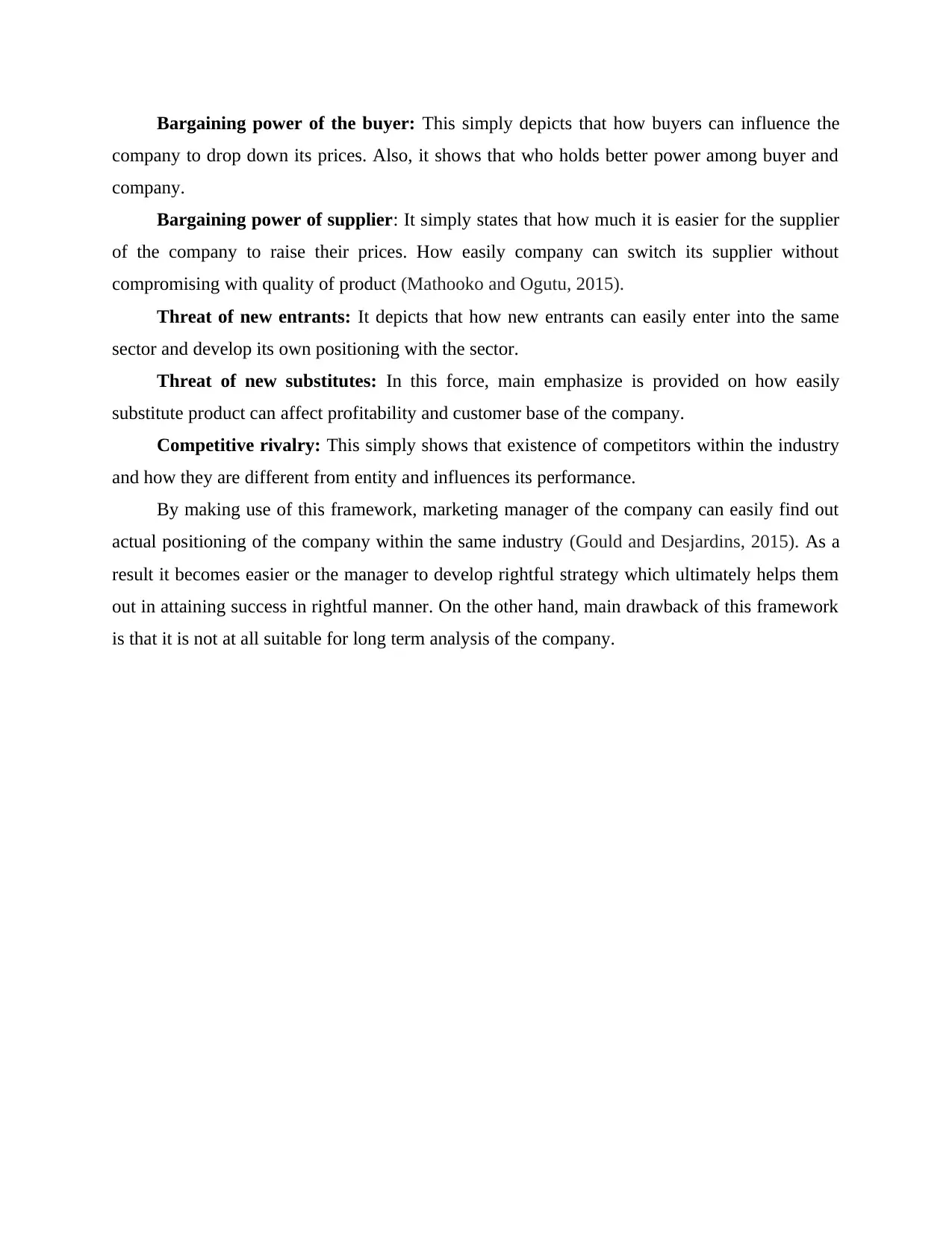
Bargaining power of the buyer: This simply depicts that how buyers can influence the
company to drop down its prices. Also, it shows that who holds better power among buyer and
company.
Bargaining power of supplier: It simply states that how much it is easier for the supplier
of the company to raise their prices. How easily company can switch its supplier without
compromising with quality of product (Mathooko and Ogutu, 2015).
Threat of new entrants: It depicts that how new entrants can easily enter into the same
sector and develop its own positioning with the sector.
Threat of new substitutes: In this force, main emphasize is provided on how easily
substitute product can affect profitability and customer base of the company.
Competitive rivalry: This simply shows that existence of competitors within the industry
and how they are different from entity and influences its performance.
By making use of this framework, marketing manager of the company can easily find out
actual positioning of the company within the same industry (Gould and Desjardins, 2015). As a
result it becomes easier or the manager to develop rightful strategy which ultimately helps them
out in attaining success in rightful manner. On the other hand, main drawback of this framework
is that it is not at all suitable for long term analysis of the company.
company to drop down its prices. Also, it shows that who holds better power among buyer and
company.
Bargaining power of supplier: It simply states that how much it is easier for the supplier
of the company to raise their prices. How easily company can switch its supplier without
compromising with quality of product (Mathooko and Ogutu, 2015).
Threat of new entrants: It depicts that how new entrants can easily enter into the same
sector and develop its own positioning with the sector.
Threat of new substitutes: In this force, main emphasize is provided on how easily
substitute product can affect profitability and customer base of the company.
Competitive rivalry: This simply shows that existence of competitors within the industry
and how they are different from entity and influences its performance.
By making use of this framework, marketing manager of the company can easily find out
actual positioning of the company within the same industry (Gould and Desjardins, 2015). As a
result it becomes easier or the manager to develop rightful strategy which ultimately helps them
out in attaining success in rightful manner. On the other hand, main drawback of this framework
is that it is not at all suitable for long term analysis of the company.
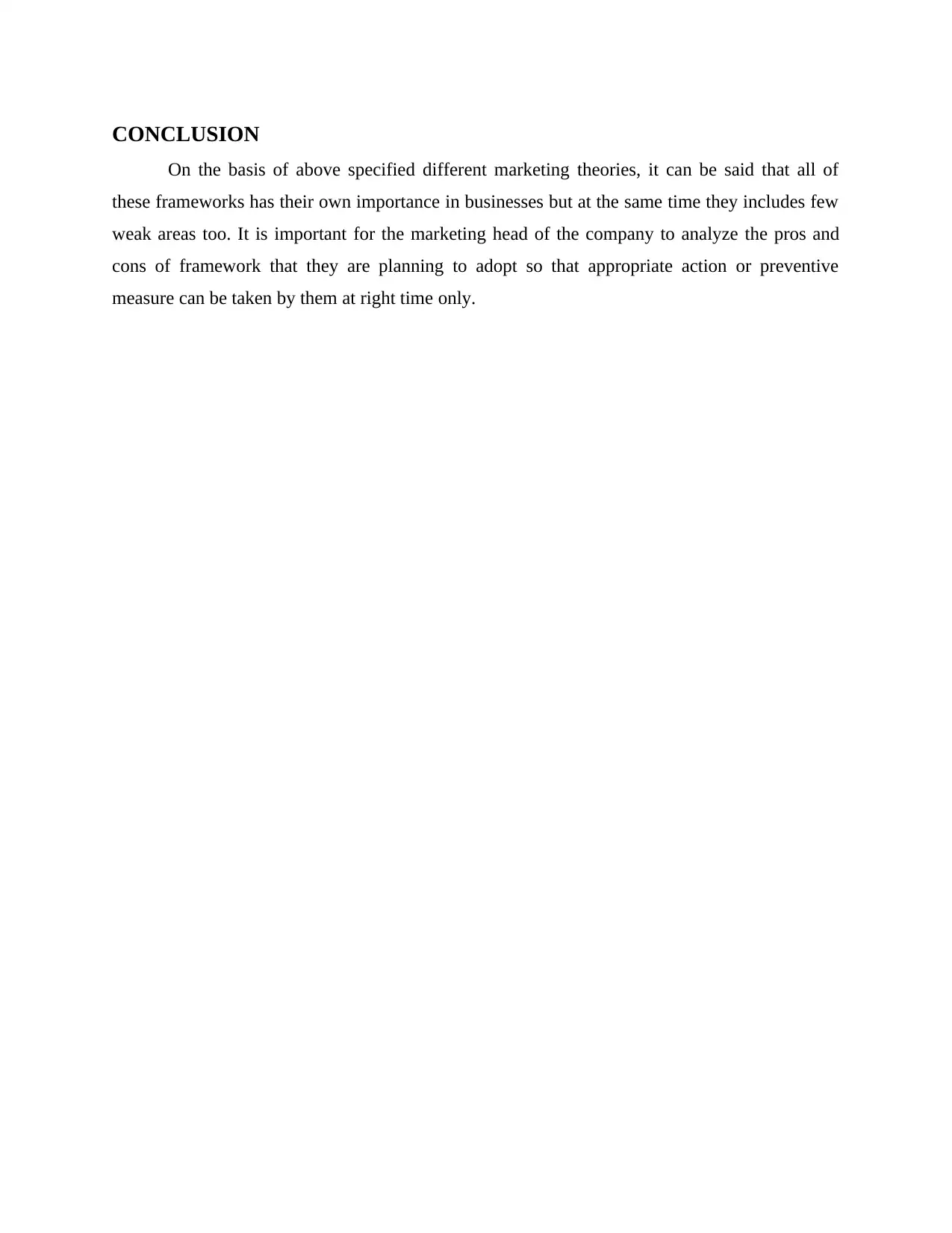
CONCLUSION
On the basis of above specified different marketing theories, it can be said that all of
these frameworks has their own importance in businesses but at the same time they includes few
weak areas too. It is important for the marketing head of the company to analyze the pros and
cons of framework that they are planning to adopt so that appropriate action or preventive
measure can be taken by them at right time only.
On the basis of above specified different marketing theories, it can be said that all of
these frameworks has their own importance in businesses but at the same time they includes few
weak areas too. It is important for the marketing head of the company to analyze the pros and
cons of framework that they are planning to adopt so that appropriate action or preventive
measure can be taken by them at right time only.
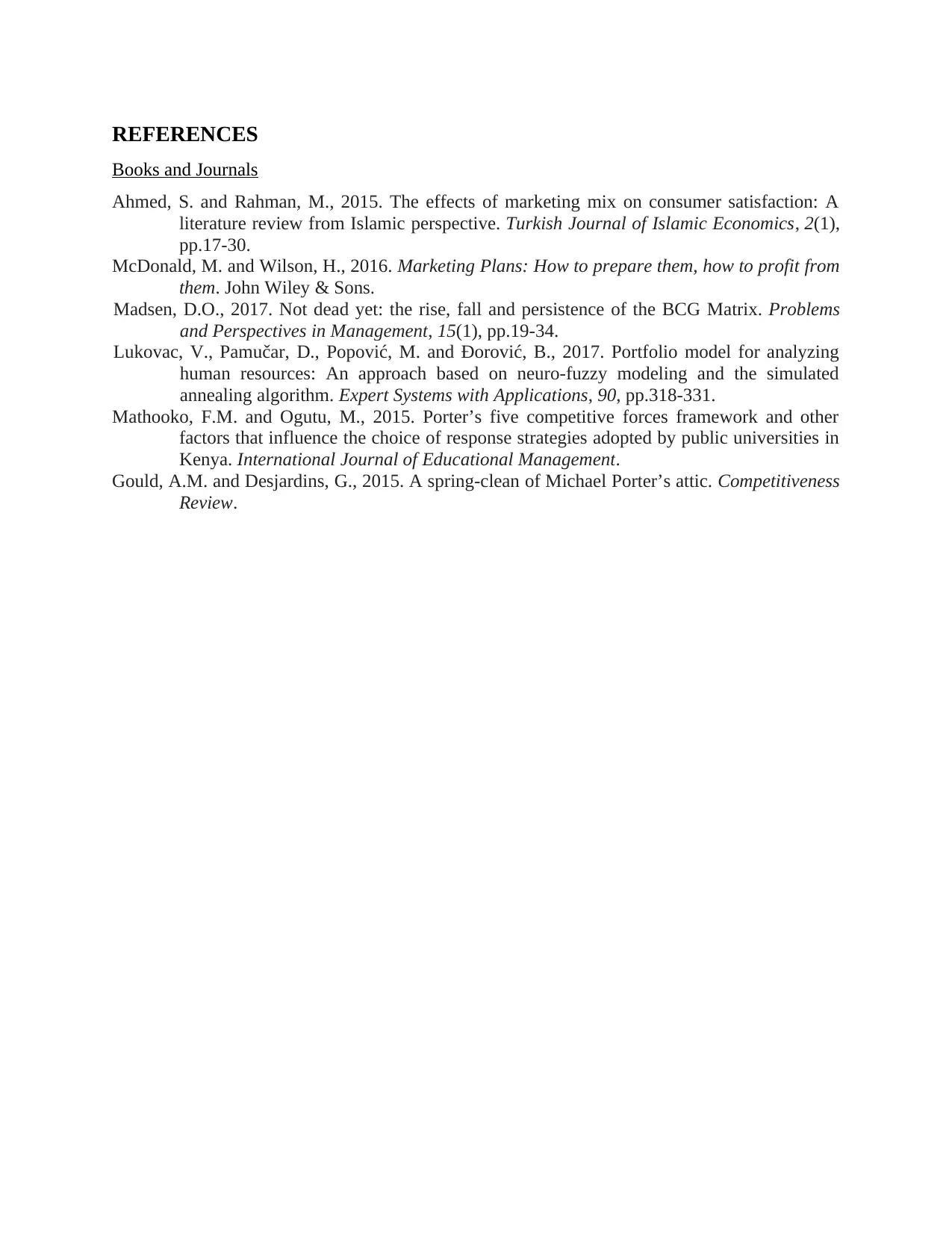
REFERENCES
Books and Journals
Ahmed, S. and Rahman, M., 2015. The effects of marketing mix on consumer satisfaction: A
literature review from Islamic perspective. Turkish Journal of Islamic Economics, 2(1),
pp.17-30.
McDonald, M. and Wilson, H., 2016. Marketing Plans: How to prepare them, how to profit from
them. John Wiley & Sons.
Madsen, D.O., 2017. Not dead yet: the rise, fall and persistence of the BCG Matrix. Problems
and Perspectives in Management, 15(1), pp.19-34.
Lukovac, V., Pamučar, D., Popović, M. and Đorović, B., 2017. Portfolio model for analyzing
human resources: An approach based on neuro-fuzzy modeling and the simulated
annealing algorithm. Expert Systems with Applications, 90, pp.318-331.
Mathooko, F.M. and Ogutu, M., 2015. Porter’s five competitive forces framework and other
factors that influence the choice of response strategies adopted by public universities in
Kenya. International Journal of Educational Management.
Gould, A.M. and Desjardins, G., 2015. A spring-clean of Michael Porter’s attic. Competitiveness
Review.
Books and Journals
Ahmed, S. and Rahman, M., 2015. The effects of marketing mix on consumer satisfaction: A
literature review from Islamic perspective. Turkish Journal of Islamic Economics, 2(1),
pp.17-30.
McDonald, M. and Wilson, H., 2016. Marketing Plans: How to prepare them, how to profit from
them. John Wiley & Sons.
Madsen, D.O., 2017. Not dead yet: the rise, fall and persistence of the BCG Matrix. Problems
and Perspectives in Management, 15(1), pp.19-34.
Lukovac, V., Pamučar, D., Popović, M. and Đorović, B., 2017. Portfolio model for analyzing
human resources: An approach based on neuro-fuzzy modeling and the simulated
annealing algorithm. Expert Systems with Applications, 90, pp.318-331.
Mathooko, F.M. and Ogutu, M., 2015. Porter’s five competitive forces framework and other
factors that influence the choice of response strategies adopted by public universities in
Kenya. International Journal of Educational Management.
Gould, A.M. and Desjardins, G., 2015. A spring-clean of Michael Porter’s attic. Competitiveness
Review.
Paraphrase This Document
Need a fresh take? Get an instant paraphrase of this document with our AI Paraphraser

1 out of 8
Related Documents
Your All-in-One AI-Powered Toolkit for Academic Success.
+13062052269
info@desklib.com
Available 24*7 on WhatsApp / Email
![[object Object]](/_next/static/media/star-bottom.7253800d.svg)
Unlock your academic potential
© 2024 | Zucol Services PVT LTD | All rights reserved.





